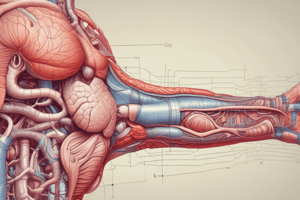Podcast
Questions and Answers
What is the main function of the villi and microvilli in the small intestine?
What is the main function of the villi and microvilli in the small intestine?
- To produce digestive enzymes
- To store nutrients for later use
- To increase the surface area for absorption (correct)
- To mix food with digestive juices
What is the primary function of pepsin in the stomach?
What is the primary function of pepsin in the stomach?
- To aid in the absorption of nutrients
- To create an acidic environment in the stomach
- To break down carbohydrates into simpler sugars
- To break down proteins into smaller peptides (correct)
What is the role of microbiota in the large intestine?
What is the role of microbiota in the large intestine?
- To ferment fiber and produce short-chain fatty acids (correct)
- To produce vitamins and hormones
- To absorb water and electrolytes
- To aid in the digestion of carbohydrates
What is the main function of the stomach?
What is the main function of the stomach?
What is the primary function of saliva in the mouth?
What is the primary function of saliva in the mouth?
What is the primary function of the large intestine?
What is the primary function of the large intestine?
What is the role of the tongue in the mouth?
What is the role of the tongue in the mouth?
What is the function of the intestinal walls in the small intestine?
What is the function of the intestinal walls in the small intestine?
Flashcards are hidden until you start studying
Study Notes
Digestive System
Mouth
- Food enters the mouth, where it is chewed by teeth into smaller pieces
- Saliva, produced by salivary glands, moistens food and breaks down carbohydrates into simpler sugars
- Tongue mixes food with saliva and forms a bolus
- Bolus is swallowed, and it passes through the pharynx into the esophagus
Stomach
- Gastric glands in the stomach lining produce gastric juice, which contains:
- Pepsin: breaks down proteins into smaller peptides
- HCl: creates an acidic environment (pH 1.5-3.5) to activate pepsin
- Mucus: protects the stomach lining from acidic gastric juice
- The stomach churns and mixes food with gastric juice for 1-2 hours
- Partially digested food, chyme, is released into the small intestine
Small Intestine
- Most of nutrient absorption occurs in the small intestine
- Villi and microvilli increase the surface area for absorption
- Brush border enzymes break down carbohydrates, proteins, and fats into simple nutrients
- Nutrients are absorbed into the bloodstream through the intestinal walls
- Pancreatic juice and bile from the liver and gallbladder aid in digestion and absorption
Large Intestine
- Water and electrolytes are absorbed from the remaining waste material
- Fiber is fermented by microbiota, producing short-chain fatty acids
- The large intestine is home to a diverse community of microorganisms, which aid in fermentation and immune system function
- Waste is formed into feces, which is stored in the rectum until eliminated through the anus
Digestive System
Mouth
- Teeth play a crucial role in chewing food into smaller pieces
- Salivary glands produce saliva, which moistens food and breaks down carbohydrates into simpler sugars
- The tongue mixes food with saliva, forming a bolus
- The bolus is swallowed, passing through the pharynx into the esophagus
Stomach
- Gastric glands produce gastric juice, containing pepsin, HCl, and mucus
- Pepsin breaks down proteins into smaller peptides
- HCl creates an acidic environment (pH 1.5-3.5) to activate pepsin
- Mucus protects the stomach lining from acidic gastric juice
- The stomach churns and mixes food with gastric juice for 1-2 hours
- Partially digested food, chyme, is released into the small intestine
Small Intestine
- Most nutrient absorption occurs in the small intestine
- Villi and microvilli increase the surface area for absorption
- Brush border enzymes break down carbohydrates, proteins, and fats into simple nutrients
- Nutrients are absorbed into the bloodstream through the intestinal walls
- Pancreatic juice and bile from the liver and gallbladder aid in digestion and absorption
Large Intestine
- Water and electrolytes are absorbed from the remaining waste material
- Fiber is fermented by microbiota, producing short-chain fatty acids
- The large intestine is home to a diverse community of microorganisms, which aid in fermentation and immune system function
- Waste is formed into feces, which is stored in the rectum until eliminated through the anus
Studying That Suits You
Use AI to generate personalized quizzes and flashcards to suit your learning preferences.




